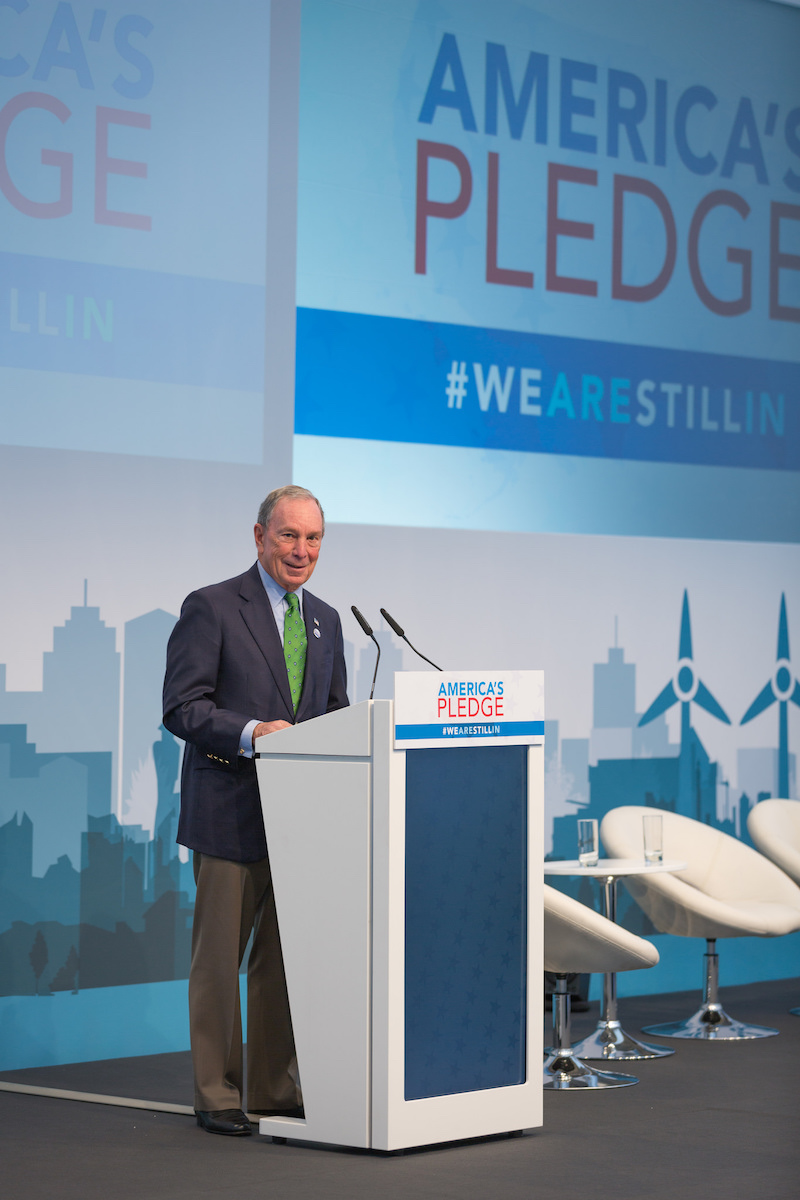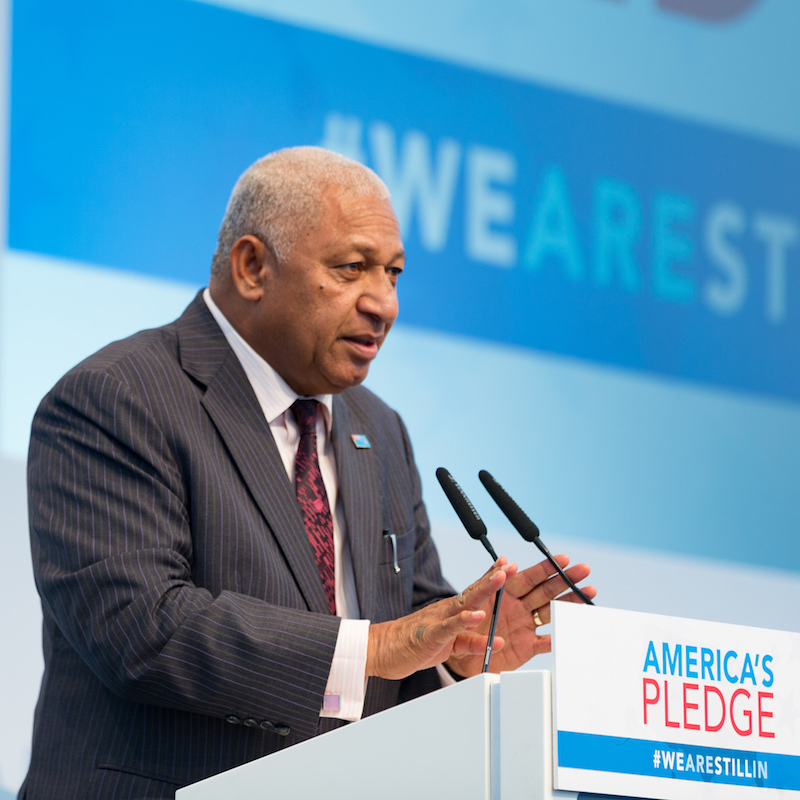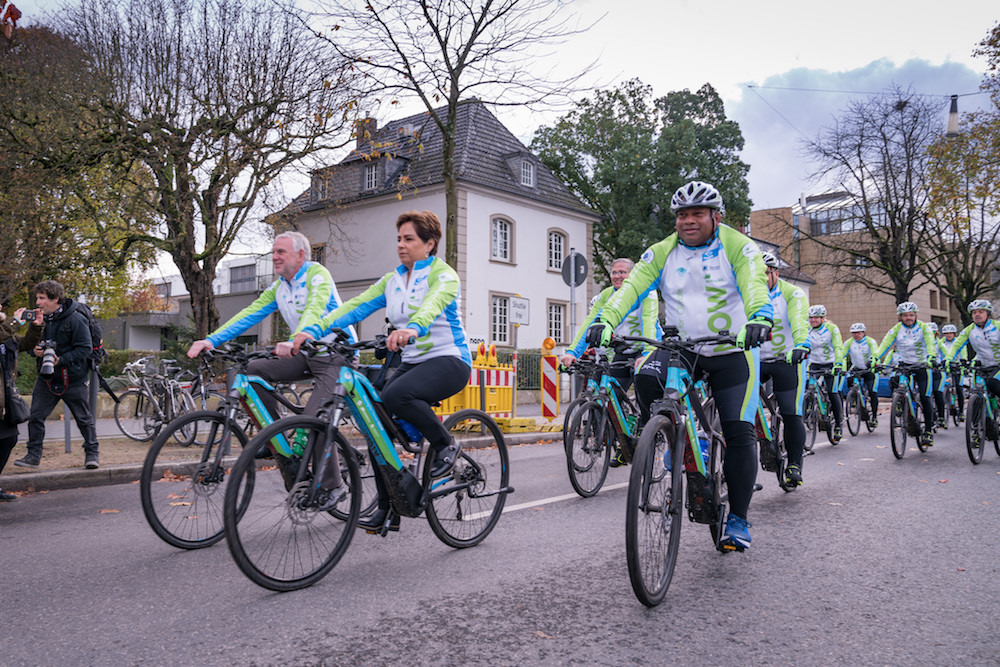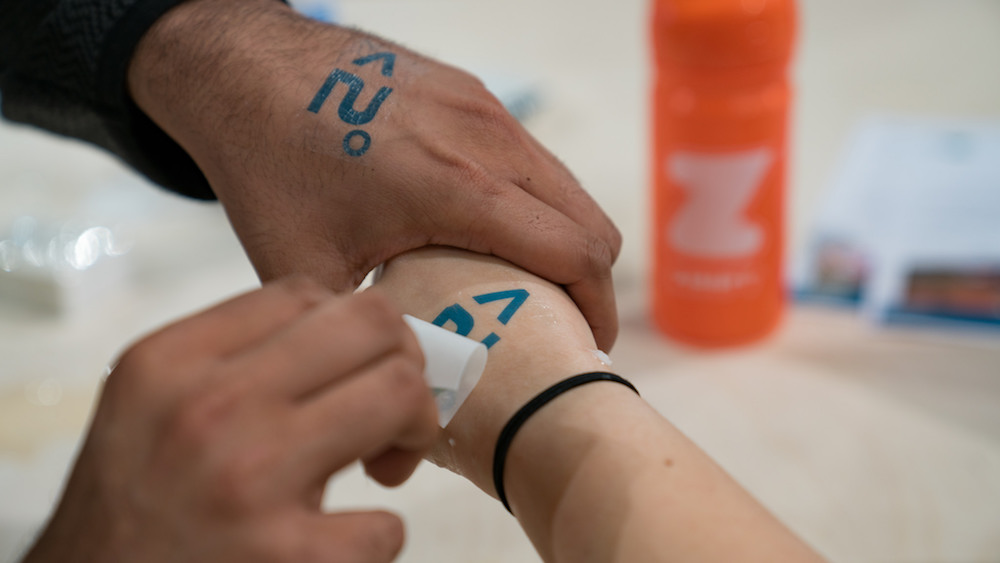Reflections on COP23: Introducing the world to “Talanoa” and more
The United Nations’ annual climate negotiations, the 23rd Conference of the Parties (COP23) of the United Nations Framework Convention on Climate Change (UNFCCC), took place from 6 to 17 November 2017. Future Earth had a major presence at the conference, which you can read more about here.
Going into COP23, I didn’t know what to expect – 2017 had been a crazy year. Not only in terms of weather, with a record-breaking hurricane season in the Caribbean, but also politically. In June, the United States announced its intention to withdraw from the Paris Agreement, a landmark international effort to combat climate change. Syria and Nicaragua, the only nations that had not yet signed onto this international agreement, ratified shortly afterward, making the United States the lone hold-out.
So let me fill you in on a few key developments coming out of COP23:
The United States is still in
It was great to see representatives from across the United States, including from city and state governments as well as businesses, stepping up to the mark in the face of the national withdrawal from the Paris Agreement. Despite not having a direct say in negotiations, diverse American leaders convened in the U.S. Climate Action Center. This pavilion provided a platform for those leaders to let the international community know that there is still a large community in the United States that believes strongly in taking action against climate change (just take a look at their #WeAreStillIn twitter campaign). One of their big projects was the America’s Pledge initiative, chaired by Michael Bloomberg, former mayor of New York City, and California Governor Jerry Brown. It represents leaders in both the private and public sector who want to ensure that the United States delivers on the ambitious climate goals of the Paris Agreement.

Michael Bloomberg, former mayor of New York City, speaks at the U.S. Climate Action Center at COP23. Photo: UN Climate Change
During COP23, this initiative released a report called “America’s Pledge Phase 1: States, Cities, and Businesses in the United States Are Stepping Up on Climate Action.” It examines current and potential opportunities for leaders outside of the federal government to help the United States reduce emissions by 26% to 28% below 2005 levels by 2025 and thereby meet the country’s commitments under the Paris Agreement – despite the United States officially reneging at a national level. U.S. states, cities and businesses, representing more than half the nation’s economy (or 6.2 trillion USD) and population (more than 130 million people), have declared their support for the Paris Agreement. More than 2,500 American leaders also signed the “We Are Still In” declaration. The initiative’s next report, due in 2018, will analyse the potential greenhouse gas reductions that states, cities and businesses might achieve in the coming years.
The official U.S. delegation, although otherwise rather quiet, did organise a “cleaner fossil fuels” side event. It was not so well received – as evidenced by the anti-Trump protesters that drowned out part of that event in song. You can watch the video here.
Coal phase-out
The United Kingdom and Canada launched the “Powering Past Coal Alliance” with the support of 25 partner countries and other actors on 16 November 2017. This alliance has a mandate to “accelerate clean growth and climate protection through the rapid phase-out of traditional coal power.”
Germany was one of the two hosts of COP23, and many felt that German Chancellor Angela Merkel, who failed to deliver a strong statement on coal, was not quite sending the right signal. Given that Germany will need to make an exit from coal to meet its commitments under the Paris Agreement, science, climate and environmental non-governmental organisations and small island developing states criticised Merkel for stating that coal, and especially lignite, must “significantly contribute to reaching the targets.”
Talanoa dialogue
At COP21, which took place in Paris in 2015, countries agreed to hold a one-off dialogue in 2018 to “take stock” of how climate action is progressing and inform the preparation of the commitments that nations have made under the Paris Agreement to reduce their greenhouse gas emissions. Originally dubbed the “facilitative dialogue,” the concept has been renamed the “Talanoa dialogue” by Fiji, the president of COP23. Talanoa is a Fijian word that reflects a process of inclusive, participatory and transparent dialogue through the sharing of stories and ideas. The hope is that the Talanoa dialogue will foster trust and stability among nations, creating a safe space where they can learn from each other.
The dialogue will focus on three main questions: Where are we? Where do we want to go? And how do we get there? Both UNFCCC member states and other groups will be able to provide input that will be incorporated into the dialogue, and an online platform will be established just for this purpose. The dialogue will provide nations with the opportunity to discuss the outcomes of the upcoming IPCC Special Report on Global Warming of 1.5°C and their implications for climate action. By discussing the implications through the sharing of stories, the dialogue will help nations to understand the impacts of such a rise in temperature from different perspectives.
Presidency’s Open Dialogue with non-governmental organisation constituencies
The Fijian Presidency held the first Open Dialogue between UNFCCC member states and other groups in the history of COPs. The dialogue was split into two sessions, each with three guiding questions. The first session focused on the enhancement and implementation of the nationally determined contributions (NDCs), while the second session looked at enhancing how observer organisations access and participate in formal meetings, such as plenaries, contact groups and subsidiary bodies.

Fijian Prime Minister Frank Bainimarama talks at an event at COP23. Fiji served as the president for this international conference. Photo UN Climate Change
The Open Dialogue was held in the spirit of the Pacific Island tradition of Talanoa. It included 50 member states and a broad mix of environmental organisations, businesses, trade unions, youth, women, indigenous peoples, local governments, farmers and research institutions. The meeting really brought an eclectic group of people into conversation about their experiences with climate change action. Fijian Prime Minister Frank Bainimarama emphasised that the purpose of the Open Dialogue was not to negotiate but to create a safe space for sharing stories, stating, “today, we will not be negotiating. We will be talking to each other. And we will be listening.”
The discussions at the Open Dialogue highlighted the importance of designing and delivering the NDCs in collaboration with groups outside the national government, such as businesses and the private sector, non-governmental organisations and research institutes. Participants put forward the idea of a national forum for gathering input from all groups, arguing that it would strengthen the marriage between UNFCCC member states and non-governmental organisations. Furthermore, some suggested that member states should develop domestic policy and a legal framework to attract non-government investment in climate solutions and to promote innovation. Lastly, indigenous peoples and considerations of human rights and gender should be recognised and embedded in the transition to climate action.
The Fijian presidency produced a full report on the Open Dialogue, which can be accessed here.
Ocean Pathway Partnership
Oceans have been a key focus area for the Fijian presidency, as evidenced by the Ocean Pathway Partnership. Small island developing states (SIDS) – or large ocean states, as they would rather be known – launched this initiative at COP23. It aims to make the ocean an integral part of UNFCCC’s efforts by 2020, with the goal of enhancing opportunities to support ocean health and manage critical coastal and marine ecosystems as climate change progresses. The Ocean Pathway Partnership is an important step forward in achieving international recognition of the impacts of climate change on the ocean, by supporting and raising awareness for ocean conservation and resilience.

Key leaders at COP23 cycle through Bonn, Germany. Photo: UN Climate Change
Joint statement from the Rio conventions
The three Rio Conventions were established in 1992 following the Earth Summit held in Rio de Janeiro. Those conventions are the United Nations Framework on the Convention of Climate Change (UNFCCC), the Convention on Biological Diversity (CBD) and the United Nations Convention to Combat Desertification (UNCCD). During COP23, the executive secretaries of these three conventions issued a joint statement calling for the establishment of a facility to secure financing for large projects that will help to address common issues. They include the CBD’s Aichi Biodiversity Targets, UNCCD’s Land Degradation Neutrality targets and UNFCCC’s NDCs and National Adaptation Plans.
The proposed facility will promote an integrated, coherent and multi-disciplinary approach to these related issues, while supporting the respective mandates of the three Rio Conventions and contributing to the 2030 Agenda for Sustainable Development. The idea is to not only deliver on existing commitments by promoting large-scale transformative projects to fill existing gaps between projects and funding but also to act as a catalyst for more coordinated action going forward.
The details of the structure and operation for this facility are still being explored in close consultation with the secretariats of the Rio Conventions and potential partners. From the perspective of Future Earth, it is particularly promising to see the conventions put a renewed emphasis on interdisciplinarity and integrated approaches to research.
Loss and damage
The topic of loss and damage is an interesting one that has been almost on the negotiating table for a number of years now. In fact, one section of the Paris Agreement recognises the importance of averting and addressing the loss and damage caused by climate change and enhancing understanding, action and support around these impacts. Loss and damage refers to not only economic damage but also the loss of biodiversity and culture due to a range of threats, including more extreme weather events and rising sea levels.
This topic is of particular urgency for developing countries, which are bearing the brunt of a changing climate. Many developed countries like the United States, on the other hand, have opposed the inclusion of loss and damage in negotiations. These nations are worried that such considerations could give developing countries the basis for a legal challenge to receive compensation for climate change-related losses.
At COP23, it was disappointing to see that loss and damage from climate change was not included as an agenda item, and no source of financing was established to compensate the affected nations and help them adapt to an uncertain future. On the bright side, Germany pledged a contribution of 125 million USD during COP23 to the InsuResilience Global Partnership, an international partnership that aims to offer affordable insurance against disaster risks for millions of people in developing countries.

An attendee at COP23 gets a temporary tattoo referencing two degrees Celsius. The Paris Agreement seeks to limit the rise in global temperatures to this target. Photo: UN Climate Change
Pre-2020 action
The Paris Agreement will only come into force in 2020. Many countries with developing and emerging economies, including China and India, were frustrated that actions to reduce greenhouse gas emissions before that date were not formally included on the agenda at COP23. At the conference, many developing countries expressed concern that developed countries won’t deliver the 100 billion USD per year that they promised for financing climate mitigation and adaption efforts until 2020. Some developing nations are also frustrated that the Doha Amendment, the follow-up to the Kyoto Protocol that covers action between 2012 and 2020, has yet to be ratified – or officially signed – by enough countries to bring it into force.
It is important for countries to ratify such agreements to continue the momentum around taking action on climate change. Countries who ratify send a message to others that climate change presents an urgent enough challenge to take action now. Otherwise, it is likely that countries will sit around and wait until 2020, when the Paris Agreement comes into effect, to begin taking action. Several countries ratified the amendment during COP23, including Germany and the United Kingdom. The European Union has indicated that it may ratify without Poland, which has, to date, held the bloc back.
Although an agenda item on pre-2020 action was not included at COP23, it was instead embedded throughout the negotiations. In the end, countries agreed to hold additional sessions throughout 2018 and 2019 to review the world’s progress in making emission reductions and produce two assessments of the state of climate financing in 2018 and 2020. Those assessments will be pulled together into a report ahead of next year's COP24 in Poland in December.
Wrapping up
In all, COP23 was an eclectic mix of policy, science and civil society actors, trying to navigate us through a time of great change. It was really interesting to see the different priorities for climate action, not only among the various member states but also among non-government organisations, businesses and indigenous groups. Overall, negotiations progressed well, although there is still a lot of work to be done. Future Earth, and the world, look forward to seeing what the future holds for climate action! I am, at least, quietly optimistic
DATE
December 20, 2017AUTHOR
Kaela SlavikSHARE WITH YOUR NETWORK
RELATED POSTS
Spotlight on LMICs – Tired of Breathing in Pollutants? Time for Better Fuel Economy and Vehicle Standards
Future Earth Taipei Holds 2024 Annual Symposium
Spotlight on LMICs – The Future’s Juggernaut: Positioning Research as Anchors for Environmental Health